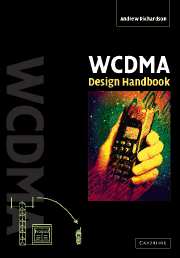Book contents
- Frontmatter
- Dedication
- Contents
- Preface
- Acknowledgements
- List of abbreviations
- 1 Introduction
- 2 WCDMA in a nutshell
- 3 Spreading codes and modulation
- 4 Physical layer
- 5 RF aspects
- 6 Chip rate processing functions
- 7 Symbol rate processing functions
- 8 Layer 2 - medium access control (MAC)
- 9 Layer 2 - RLC
- 10 PDCP and BMC protocols
- 11 Layer 3 - RRC
- 12 Measurements
- 13 NAS
- 14 Idle mode functions
- Appendix
- References
- Index
3 - Spreading codes and modulation
Published online by Cambridge University Press: 05 October 2013
- Frontmatter
- Dedication
- Contents
- Preface
- Acknowledgements
- List of abbreviations
- 1 Introduction
- 2 WCDMA in a nutshell
- 3 Spreading codes and modulation
- 4 Physical layer
- 5 RF aspects
- 6 Chip rate processing functions
- 7 Symbol rate processing functions
- 8 Layer 2 - medium access control (MAC)
- 9 Layer 2 - RLC
- 10 PDCP and BMC protocols
- 11 Layer 3 - RRC
- 12 Measurements
- 13 NAS
- 14 Idle mode functions
- Appendix
- References
- Index
Summary
Introduction
In this chapter we consider the basic principles of operation of the different codes used in the WCDMA system and the modulation scheme that is closely associated with the codes. To start we consider both of these from a general perspective before applying the concepts to the specific situation of the WCDMA system.
We introduce the concepts of spreading and modulation. Spreading is the process fundamental to the operation of the WCDMA radio interface, so we shall spend some time considering what it is and how it works. Modulation is the mechanism for superimposing the spread information onto an RF carrier. Whilst this part of the procedure is very similar to that in similar digital communication systems, spreading introduces some additional complications that we need to consider.
First, we will consider the basic principles of spreading. To do this we need to review what we are trying to achieve in using these spreading functions and subsequently how we can achieve this.
In studying these concepts, we need to introduce something generically referred to as a spreading code (we will see later that there are a number of different types of codes under this general umbrella). We should be careful not to become confused between these codes and the other codes that exist in the WCDMA system. The other codes, often referred to as error correcting or error detecting codes, are there to protect the data being transmitted across the radio interface.
- Type
- Chapter
- Information
- WCDMA Design Handbook , pp. 64 - 114Publisher: Cambridge University PressPrint publication year: 2005



